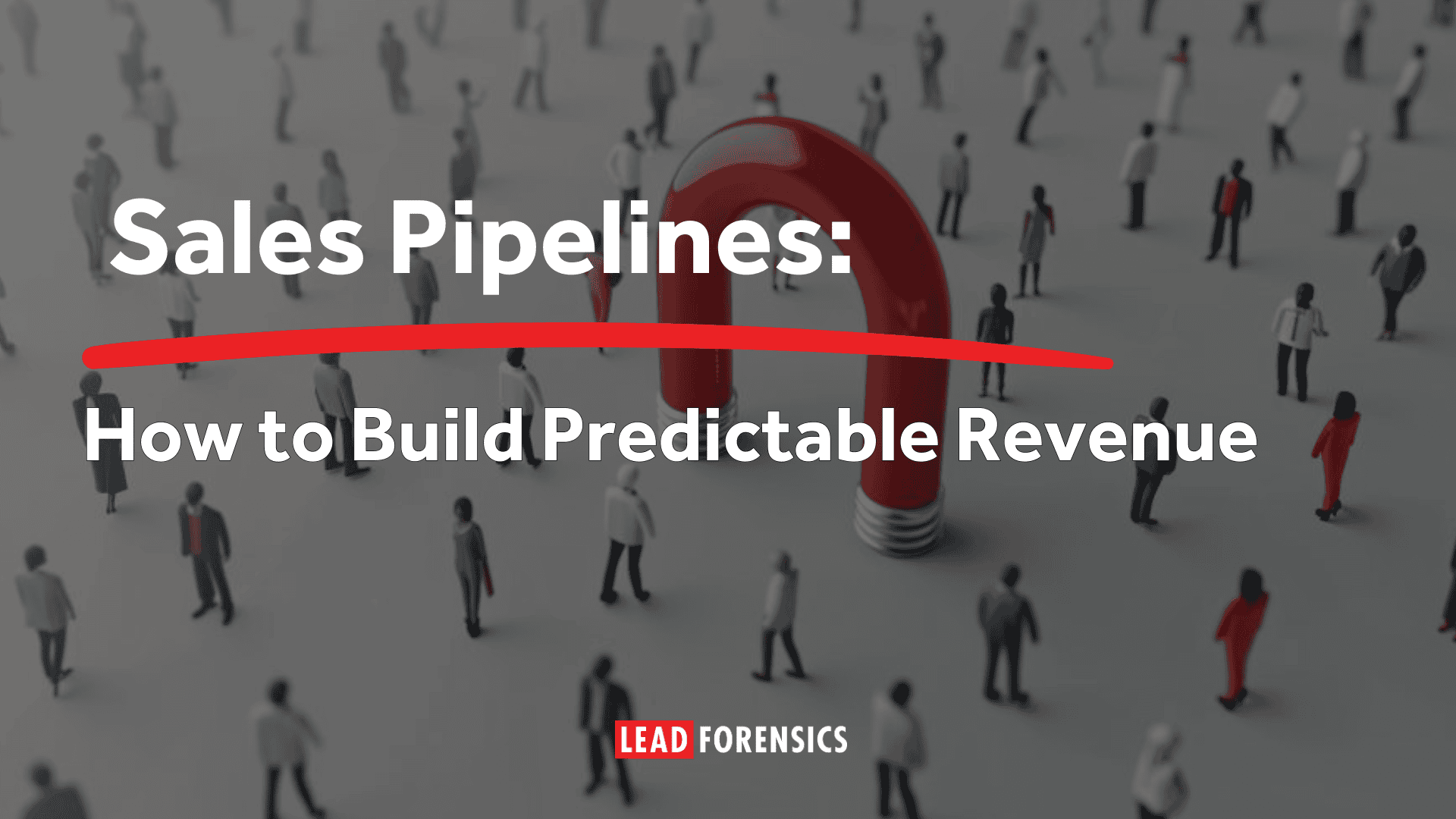A strong sales pipeline is a buffer of qualified opportunities that’ll help you meet (and hopefully exceed) sales targets. If that buffer is absent, you’re stuck with unpredictable revenue, slower growth, and a general sense of unease. Studies show that companies with weak sales pipeline coverage struggle to forecast accurately and see higher churn rates over time.
That cycle is draining.
Well-managed sales pipeline, though, can ease the pressure by letting your team forecast more confidently and maintain consistent momentum. In this post, we’ll discuss why sales pipelines go missing and how to fix them with strategies like account-based marketing (ABM), visitor identification software, and AI-driven analytics. These steps can help your sales team fill pipeline gaps, reduce stress, and create a path to predictable revenue.
Why Missing Sales Pipelines Matter
If there aren’t enough high-quality leads in your funnel, quotas become guesswork. That kind of uncertainty complicates budgeting and resource allocation. Everyone hates unwelcome surprises around revenue, and an unreliable pipeline often leads to more of these surprises than anyone wants.
Sales reps feel the strain too. When there aren’t enough leads, they may cling to deals that don’t truly fit. They can spend too much time on the wrong opportunities simply because there’s nothing else in the pipeline. As the end of the month or quarter approaches, everyone scrambles to salvage deals in progress. This environment creates stress, frustration, and can lower morale.
A shaky pipeline also has ripple effects across the organization. Forecasts become less reliable, which hurts your credibility. Marketing has a harder time planning campaigns when it’s not clear what sales truly needs. In short, missing pipeline affects nearly every part of the sales and marketing ecosystem.
Measuring the Pipeline Gap
Before you try to fix your missing pipeline, you need to measure it. A popular approach is the pipeline-to-quota ratio. Many experts say your pipeline should be about three to five times your overall quota. If your quarterly quota is $500,000, you’ll want between $1.5 and $2.5 million in potential deals.
However, that ratio alone doesn’t show you the entire picture. Your average deal size, win rate, and sales velocity also matter. Large deals can mean fewer total opportunities, but they raise your risk if one or two fail to close. If your team closes around 20% of its leads, you’ll need a bigger pipeline than a team closing at 40%.
Sales velocity – how fast deals move from initial contact to signing – also changes how much coverage you need. A slow sales cycle might demand a higher coverage ratio to account for longer deal times.
By examining these metrics together, you’ll get a more accurate view of your pipeline gap. You might think your pipeline’s large enough, only to realize deals are creeping along at a snail’s pace. Once you factor that in, a gap emerges. This process of quantification is the first step in identifying the root issues behind missing pipeline.
Plus research from Forbes shows that companies with accurate sales pipelines are 10% more likely to experience revenue growth, so accuracy is key!

Root Causes of Missing Sales Pipelines
A missing pipeline usually doesn’t happen overnight. It’s often the result of several smaller problems that build up over time. One big culprit is weak prospecting. Maybe your reps are busy servicing existing accounts, leaving little time for outbound outreach. Or perhaps they’re overly dependent on inbound leads, which aren’t always steady.
Low conversion rates can also shrink your pipeline. If your funnel is loaded with unqualified leads, reps spend hours on calls that never materialize into closed deals. Inconsistent follow-ups can make things worse. Without a clear qualification process, your team might not know when to focus on a deal or when to let it go.
There’s also the issue of overreliance on a single massive deal – landing one huge account might look great on paper, but it’s a risky move. If that deal falls through, your entire quarter can be in jeopardy. Limited visibility compounds the situation. Managers need to see deals in every stage to spot problems early. If they don’t, pipeline bottlenecks can remain hidden until it’s too late to rescue the quarter.
Building a More Reliable Pipeline
Fixing a missing pipeline means attacking the problem from multiple angles. If inbound leads are your main source, consider adding outbound tactics to diversify your funnel. Account-based marketing (ABM) is one approach many teams use.
ABM narrows your focus to key target accounts, letting sales and marketing craft messaging specific to those companies. It’s more personalized than a blanket campaign, so the leads you get from ABM are usually more aligned with your ideal customer profile.
Visitor identification software can help you expand your pipeline too. Tools like Lead Forensics identify which companies visit your website, even if they don’t fill out a form. This data gives you a chance to contact them directly based on what they’ve viewed. It’s an opportunity to catch potential buyers earlier, which can lead to more qualified conversations.
Lead qualification is another piece of the puzzle. If you adopt a consistent scoring model, reps won’t chase poor-fit leads. This saves time and boosts conversion rates because everyone zeroes in on the best opportunities. Qualification criteria might include company size, industry, or known challenges that align with your solution.
Diversifying your lead sources is also a good idea because if you’re heavily tied to just one channel, a sudden dip can hurt your entire quarter. By balancing inbound, outbound, partner referrals, events, and more, you spread your risk. This doesn’t mean you should chase every lead that appears, but having multiple well-run channels can smooth out the pipeline.
It’s also smart to revisit your follow-up process. When people don’t hear from you promptly, they can lose interest or move on to competitors. Automated tools like Outreach or Salesloft keep leads warm without placing a huge burden on reps. You can create a series of personalized emails, calls, or social touches that go out at the right intervals, ensuring no promising lead slips away.
Case Studies – Turning Missing Pipeline into Revenue
Here are some examples from Lead Forensics customers that demonstrate how real-world companies grow their sales pipelines.
Hotwire: A communications agency and Lead Forensics partner, Hotwire used the platform to support their Account-Based Marketing (ABM) campaigns. By using Lead Forensics’ insights, they achieved $100 million in pipeline revenue and secured 100% engagement across their target market.
Mac’s Truck Sales: Specializing in new and used trucks, Mac’s Truck Sales aimed to increase their monthly leads by 5-10 through Lead Forensics. The platform enabled them to better manage their sales pipeline and follow-up processes, especially with existing customers. Over just two months, they generated over £1 million in additional revenue.
Shortlist Marketing: This company doubled their pipeline efficiency with Lead Forensics, resulting in £49,000 of pipeline revenue from the leads identified by the platform.
Action Steps to Fix Missing Sales Pipeline
Fixing a missing pipeline isn’t an overnight job, but small, deliberate changes add up to major improvements. Start with daily prospecting sessions. Block out time when your reps do nothing but research leads, send outreach emails, or make calls. This daily commitment keeps a steady stream of new opportunities flowing in.
Hold weekly pipeline reviews. During these meetings, your reps can talk about any deals that are stuck or highlight potential wins. Managers can spot warning signs before they develop into full-fledged crises. This keeps pipeline issues in the open instead of letting them fester.
Once a quarter, dig deeper. Look at data like conversion rates, average deal sizes, and actual results. Are there any patterns that suggest your sales approach isn’t working in a certain industry? Are some reps consistently outperforming others at a certain stage? Use these insights to adjust your strategies. Also consider alignment between sales and marketing during these deeper audits. Make sure everyone’s aiming at the same buyer personas and speaking the same language.
Following this daily-weekly-quarterly cycle helps you stay proactive about pipeline health. You won’t be blind to what’s really happening, and you’ll have the data to make sound decisions. Over time, you’ll likely see a more consistent flow of deals and fewer last-minute scrambles.
Final Thoughts
Predictable revenue is the outcome of proper pipeline management that balances good process, teamwork, and technology. With a robust pipeline, you’ll see fewer abrupt surprises, happier sales reps, and more confident planning. That sense of control and stability is something every sales organization can strive for – and achieve.










